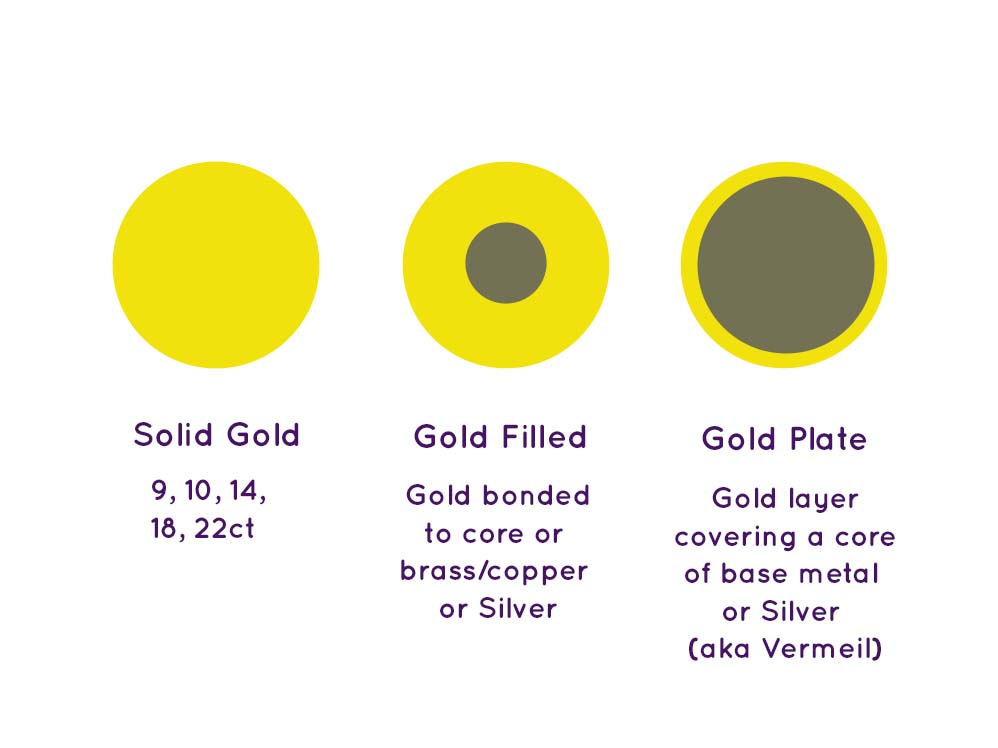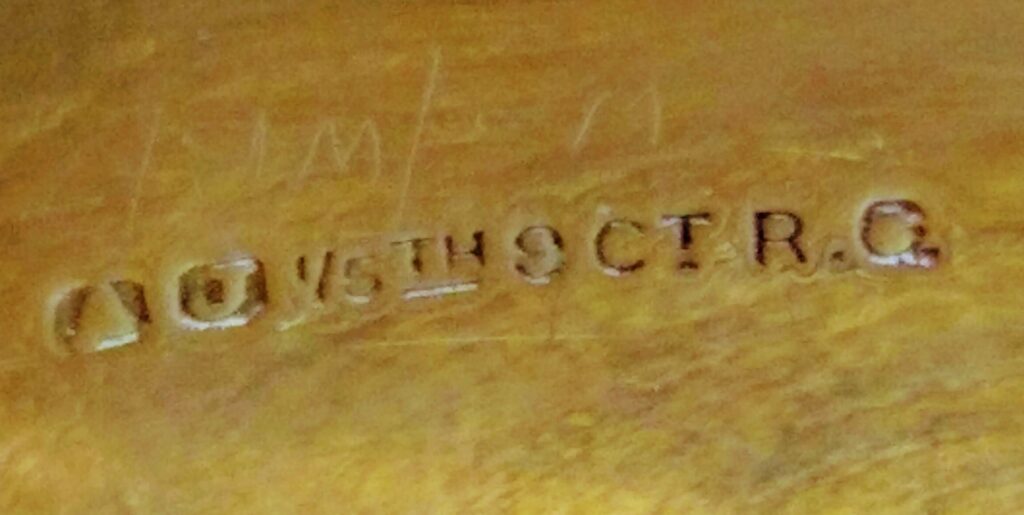People often ask me what the difference between the three terms is so I thought I’d write a little post to try to clarify the differences. There is a difference between each term and the value they bring.
Q: What is Gold Filled?

A: Gold filled is a thick layer of carat gold heat and pressure bonded to a metal core usually brass or copper. In some instances the core is sterling silver, however this is rarer because of the cost of silver. It was more common in the 1930’s/40’s. In the US the minimum carat of gold bonded is 10ct and in Europe is it 9ct. But you can find gold filled in 14ct, 18ct and 22ct as well
Q: What is Gold Vermeil?
A: Gold Vermeil sometimes shortened Vermeil is Silver (usually sterling or fine silver) plated (coated) with a thin layer of Gold. The plating is usually between 2.5-5 microns thick. It can be as little as .5 microns. To put that into context a human hair is between 50-90 microns.
Q: What is Gold Plate?
A: Gold plate is a thin layer of gold, plated to a base metal other than Silver. The base metal is usually a copper/brass alloy. As with Vermeil, the gold layer is 2.5-5 microns thick.
Q: How much gold is in Gold Filled or Gold Plated jewellery?
A: That depends on a few things. The next question answers for gold filled. In Gold Plated jewellery, the gold content is almost immeasurable and so very little gold is present.
Q: What marks are found on Gold filled jewellery
A: Modern Gold Filled jewellery will bear a stamp of either GF or RG (rolled gold) accompanied by the carat of the gold and the amount of gold in the piece. So for example, you might see: 1/20 12KT GF (sometimes written 12/20 GF). This means that the item contains 1/20th by overall weight 12ct Gold or 5% of the total weight of the item is 12ct Gold. In the US the minimum amount of gold by weight is 1/20th or 5% and the minimum carat is 10K. A gold content of 5% tends to be standard now in most modern gold-filled jewellery today.

The piece of jewellery to the left is an antique bracelet bearing the marks AJ 1/5th 9ct RG. The letters AJ are the makers mark. The remainder of the marks indicate the weight and carat and type of material. The 1/5th 9ct Gold means the bracelet contains 20% gold by weight of 9ct Gold. The RG stand for rolled gold (the same thing as gold filled). Antique gold filled jewellery usually has a much higher gold content that modern commercial gold filled jewellery. In the UK gold filled jewellery cannot be hallmarked as the gold content is not deemed sufficient.
Q: What if my jewellery does not have any markings on it?
A: In general I would suggest to avoid buying jewellery without any markings. However if you really love the piece and you are happy to pay the amount being asked, then go for it! Fashion jewellery is the prime example here. It’s meant to last for a season or two.
Q: I have an old piece of gold jewellery, how can I tell if it is gold or gold filled or gold plate.

A: There is no easy way to tell if it is real gold, filled or plated when there are no markings. However you can look for some tell tale signs. Gold filled jewellery may show signs of tarnish or blackening at cut ends.
This is because the non-gold core of the metal is exposed at the cut end. Because of the way gold filled metal is created, it can only be manufactured into wire or sheet. As a result, any ewellery designed from gold filled wire or sheet will have “cut ends” that expose the inner non-gold core. So for example, look at the photo to the right. The cut end, where the clasp is has blackened from tarnish. This is a clear indicator that this is gold filled. That said, when the bracelet is closed, you will hardly notice the tarnishing. Carat gold does not tarnish (the exception is lower carat gold such as 9ct, but it will not blacken as in the photo)
Alternatively you can test the metal for purity using an acid test. This type of test is destructive and requires filing deeply into the metal so that you can test the internal metal with acid. Sometimes this is not desirable as it may ruin the piece of jewellery. If you refer to the diagram above, you can see you’ll need to file quite deeply to test for gold filled. Gold plate will be be revealed by light filing. You can also sometimes use a very powerful magnet as sometimes the inner core is magnetic. If the item is magnetic then it is categorically not gold
Q: I have a piece of marked gold filled jewellery I would like to have melted and turned into a new piece of jewellery. Can I do this?
A: Unfortunately gold filled and gold plate jewellery cannot be melted down to turn into new jewellery. Only carat gold (or silver) can be melted. You could potentially send your jewellery to a manufacturer who can smelt and process your jewellery to separate the gold from base metals. However this is not cost effective in small quantities.
Q: Which should you buy?
A: That really depends on you. But here are some things to consider.
- Gold Filled jewellery is fairly robust. Because of the thick coating of gold it can wear well for anything between 10-20 years and sometimes more depending on how often you wear it and take care of it. Rings will wear quicker than earrings or pendants.
- Gold Plate jewellery (including Vermeil) are good for fashion jewellery or jewellery you do not plan to wear often or alterntively if you like the look of gold but not the price tag. Gold plated jewellery will last several months to a few years if cared for. One thing to avoid is getting gold plated jewellery wet. It can cause the plating to prematurely wear off.
Q: How much does Gold Filled cost compared to Gold Plate?
A: Gold filled jewellery prices will vary somewhat with the price of gold. At the moment, gold filled jewellery is about 10-20% more than its Sterling Silver equivalent. Gold plate is considerably less expensive than Silver because of the high base metal content. Vermeil is marginally more expensive than Silver.
Final word:
While I don’t use plating on Inari Designs jewellery I do use the ancient Korean/Asian technique of Keum Boo to add 24k gold accents to sterling and fine silver. Keum boo is the bonding of pure gold to silver using heat and pressure in a similar way to gold-filled. I have chosen this technique over plating as it does not require the use of chemicals such as cyanide in the process. Thus I believe it is a more environmentally friendly option. Pop over to the shop to see some of my Keum Boo Jewellery .
These are just a few bits and pieces for your information. If you have a question I haven’t covered, please put it in the comments below and I will add it to the blog post. Thank you for reading!!